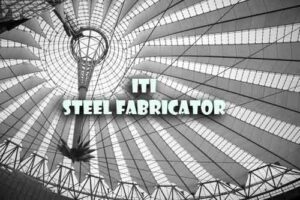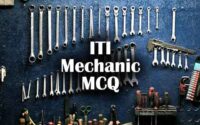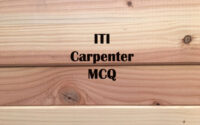ITI Steel Fabricator Questions and Answers
ITI Steel Fabricator Questions and Answers papers are given in this section. Direct download links for the Steel Fabricator exam are here. Hope our Steel Fabricator study material helps you in scoring marks. Find the direct download link for Steel Fabricator Question Paper in Pdf in the section below.

The Steel Fabricator Previous Year Question Paper is helpful for the applicants in their preparation. However, here is an overview of ITI Steel Fabricator Recruitment. Download the Steel Fabricator Previous Year Question Paper Pdf given in the section below. In this page, you can find the Steel Fabricator Old Question Papers.
These Previous Papers will be helpful for the applicants of ITI Steel Fabricator Jobs. The candidates can start preparing for the written test after downloading the Last 5 Years Steel Fabricator Exam Papers. The downloaded ITI Steel Fabricator Sample Papers will be useful for the applicants’ proper preparation
MCQ Objective Questions and Answers for Steel Fabricator
1. The thickness of the SWG No: 10 is:
(A) 2.6 mm
(B) 2 mm
(C) 3.2 mm
(D) 1.6 mm
2. Maximum SWG number is:
(A) 50
(B) 1/0
(C) 1
(D) 7/0
3. Mass/unit. area for 1 mm thick stool is:
(A) 8.65 Kg/m2
(B) 5.3 Kg/m2
(C) 7.73 Kg/m2
(D) 6.66 Kg/m2
4. Unit of force in S.I system:
(A) Kg
(B) N
(C) Kgf
(D) N-m
5. What is Young’s modulus of elasticity?
(A) Force/area
(B) Stress/strain
(C) Load/area
(D) strain/stress
6. Unit. of stress in S.I system:
(A) N/m
(B) N/m2
(C) N/m
(D) n/m3
7. Melting point of pure aluminum is:
(A) 419°C
(B) 232°C
(C) 660°C
(D) 1300°C
8. Density is:
(A) mass/area
(B) force/area
(C) mass/volume
(D) volume/mass
9. Melting point of Tin in:
(A) 419°C
(B) 232°C
(C) 660°C
(D) 1300″C
10. Unit of length in metric system:
(A) inch
(B) cm
(C) Mm
(D) m
11. The perimeter of a circle diameter ‘d’ is:
(A) Πd
(B) 2πd
(C) 1/3πd
(D) 4/3πd
12. Which is the lowest value?
(A) ½
(B) ¼
(C) 1/3
(D) 2/3
13. The value of 5/100 + 3/I000 is:
(A) 5.3
(B) 0.053
(C) 0.53
(D) 0.0053
14. Unit of electric current is:
(A) Volt
(B) Walls
(C) Amp
(D) Ohm
15. Mallet is made of:
(A) Steel
(B) hard wood
(C) wrought Inon
(D) cast iron
16. Angle of dot punch is:
(A) 30°
(B) 60°
(C) 45°
(D) 90°
17. If wire diameter ‘D’ the wiring allowance for sheet metal work is:
(A) 1.5D
(B) 2D
(C) 2.5D
(D) 3D
18. Which is the leak proof joint in sheet metal work?
(A) pane
(B) grooved
(C) lock grooved
(D) riveted
19. The ability of material to resist fracture due In high impact load is:
(A) strength
(B) stiffness
(C) toughness
(D) hardness
20. The properly of material which enables it to retain the deformation permanently is
(A) Brittleness
(B) Ductility
(C) Malleability
(D) plasticity
21. Which of the following material has maximum ductility?
(A) mild steel
(B) copper
(C) aluminum
(D) zinc
22. The properly of n material due to which it breaks with little permanent distortion:
(A) brittleness
(B) ductility
(C) malleability
(D) plasticity
23. Which of the following material has maximum malleability?
(A) Copper
(B) soft steel
(C) wrought iron
(D) lead
24. Iron ore is usually found in form of:
(A) Oxides
(B) Hematite
(C) limonite
(D) pyrite
25. Steel containing 0.8 to 1.5% carbon is known as:
(A) mild steel
(B) dead mild steel
(C) medium carbon steel
(D) high carbon steel
26. Cutting tools are made from:
(A) nickel steel
(B) chrome steel
(C) high speed steel
(D) silicon steel
27. Which of the following is an amorphous material?
(A) glass
(B) mica
(C) lead
(D) brass
28. The heat. treatment process used for softening hardened steel:
(A) Carburizing
(B) Normalizing
(C) Annealing
(D) tempering
29. Which of the following is a case hardening process?
(A) Curburizing
(B) Cyaniding
(C) Nitriding
(D) all of the above
30. Brass is an alloy of:
(A) copper & zinc
(B) copper & Tin
(C) copper, zinc & tin
(D) none of the above
31. Bronze is an alloy of:
(A) copper & zinc
(B) copper & tin
(C) copper, zinc & tin
(D) none of the above
32. Structural sections which as rail, angles, l Beams are made by:
(A) hot rolling
(B) hot drawing
(C) hot extrusion
(D) hot spinning
33. The parts of circular cross section which are symmetrical about the axis of rotation are made by:
(A) hot forging
(B) hot spinning
(C) hot extrusion
(D) hot drawing
34. The process extensively under for making bolt and nut is:
(A) hot piercing
(B) extrusion
(C) cold peeping
(D) cold heading
35. The process of increasing the cross section of a bar and decrease its length is called:
(A) drawing-down
(B) upsetting
(C) spinning
(D) peening
36. The process of decreasing the cross-section of a bar and increasing its length is called:
(A) drawing down
(B) upsetting
(C) spinning
(D) peening
37. The operation of cutting 0. cylindrical hole in a sheet of metal by the punch and the die is called:
(A) Shearing
(B) Piercing
(C) Punching
(D) blanking
38. The operation of cutting a flat sheet to the desired shape is called:
(A) Shearing
(B) Piercing
(C) punching
(D) blanking
39. The operation of cutting a sheet of metal in a straight line along the length is known as:
(A) Plunging
(B) Notching
(C) Slitting
(D) forming
40. The operation of bending a sheet of metal along a curved axis is known as:
(A) Plunging
(B) Notching
(C) Slitting
(D) forming
41. The operation of producing cup shaped parts from flat sheet metal blanks by bending and plastic flow of metal is known as:
(A) Drawing
(B) Squeezing
(C) Coining
(D) embossing
42. The operation of straightening a curve sheet metal is known as:
(A) Drawing
(B) Squeezing
(C) Coining
(D) planishing
43. Blanking and piercing operation can be performed simultaneously in a:
(A) single die
(B) compound die
(C) progressive die
(D) combination die
44. Cutting and forming operation can be performed in a single operation in a:
(A) single die
(B) compound die
(C) progressive die
(D) combination die
45. ln piercing operation. the clearance is provided on:
(A) punch
(B) half on the punch & half on the die
(C) die
(D) either on punch or die
46. In blanking operation, the clearance is provided on:
(A) Punch
(B) Die
(C) half on the punch & half on the die
(D) oil-her on punch or die
47. Lap joints are employed on plates. having thickness:
(A) less than 3 mm
(B) 5 to 10 mm
(C) 12.5 mm
(D) above 25 mm
48. Seam welding is beat adopted for metal thickness ranging from:
(A) 0.025 to 3 mm
(B) 5 to 8 mm
(C) 3 to 5 mm
(D) 8 to 10 mm
49. Acetylene gas is stored in cylinder in the form of:
(A) Solid
(B) Gaseous
(C) Liquid
(D) any one of the form
50. The oxygen cylinder is usually painted with:
(A) black colour
(B) maroon colour
(C) white colour
(D) yellow colour
51. Flux commonly used in brazing is:
(A) zinc chloride
(B) ammonium chloride
(C) rosin plus
(D) borax
52. A zinc diffusion process is called:
(A) Galvanizing
(B) Anodizing
(C) parkerising
(D) shemdising
53. In order to cut mild steel, the cutting angle of chisel should be:
(A) 30°
(B) 45°
(C) 50°
(D) 60°
54. The cold chisel are made by:
(A) Drawing
(B) Rolling
(C) Piercing
(D) forging
55. The cross section of a chisel is usually:
(A) Circular
(B) Square
(C) hexagonal
(D) octagonal
56. The cutting edge of a chisel should:
(A) Hardened
(B) Tempered
(C) annealed
(D) hardened and tempered
57. A hacksaw blade cuts on the:
(A) forward stroke
(B) return stroke
(C) both return and forward
(D) cutting depends up on the direction of force
58. A hack saw blade is specified by its:
(A) Length
(B) Materials
(C) Width
(D) number of teeth
59. To prevent the body of the blade from jamming in the saw cut; the teeth of the blade are
(A) Strengthened
(B) Set
(C) Sharpened
(D) all of the above
60. A file with 20 teeth in 25 mm is called:
(A) rough file
(B) second cut file
(C) bastard file
(D) smooth file
61. A file removes the metal during:
(A) forward stroke
(B) both forward and return stroke
(C) return stroke
(D) none of the above
62. The type of file used for n wood work in:
(A) single cut file
(B) rasp cut file
(C) double cut file
(D) any one of the above
63. The instrument used to measure external and internal diameter of shafts, thickness of parts and depth of holes is:
(A) outside micrometer
(B) vernier caliper
(C) inside micrometer
(D) depth gauge micrometer
64. The accuracy of micrometers, calipers, dial indicators can be checked by:
(A) feeler gauge
(B) slip gauge
(C) ring gauge
(D) plug gauge
65. A ring gauge is used to:
(A) check the diameter of shafts
(B) test the accuracy of holes
(C) check the clearance between two mating surface
(D) all of the above
66. The drill spindles are provided with standard taper known as:
(A) morse taper
(B) seller taper
(C) champman taper
(D) brown and sharp taper
67. The operation making a cone shaped enlargement. of the end of ii hole is known as:
(A) counter sinking
(B) trepanning
(C) counter boring
(D) spot facing
68. Which of the following operation is first performed?
(A) spot facing
(B) tapping
(C) boring
(D) drilling
69. The drill mainly used in drilling brass, copper or softer
(A) flat drill
(B) parallel shank twist drill
(C) straight fluted drill
(D) tapered shank twist drill
70. The usual value of the point angle of a drill is:
(A) 70°
(B) 118°
(C) 100°
(D) 130°
71. For softer materials the point angle of a drill is:
(A) equal to 118°
(B) more than 118°
(C) less than 118°
(D) any one of the above
72. Twist drill are made of:
(A) high speed steel
(B) stainless steel
(C) carbon steel
(D) either (A) or (B)
73. A tool used to withdraw a drill from the sleeve is called
(A) drill remover
(B) drill puller
(C) drift
(D) drill drawer
74. The unit of temperature in S.I. system:
(A) °C
(B) °K
(C) °F
(D) J
75. V block is used to:
(A) check the trueness of flat surface
(B) check the surface roughness
(C) locate centre of round roads
(D) none of the above
76. Thin gears from sheet metal can be produced commercially by:
(A) gear hobbing
(B) gear shaping
(C) extruding
(D) stamping
77. A good lubricant for thread cutting operation:
(A) Graphite
(B) white load
(C) mineral lard oil
(D) water soluble nil
78. Surface grinding is done to produce:
(A) tapered surface
(B) flat, surface
(C) internal cylindrical hole
(D) all of the above
79. The process of improving the cutting action of the grinding wheel is called
(A) Truing
(B) Dressing
(C) Facing
(D) clearing



